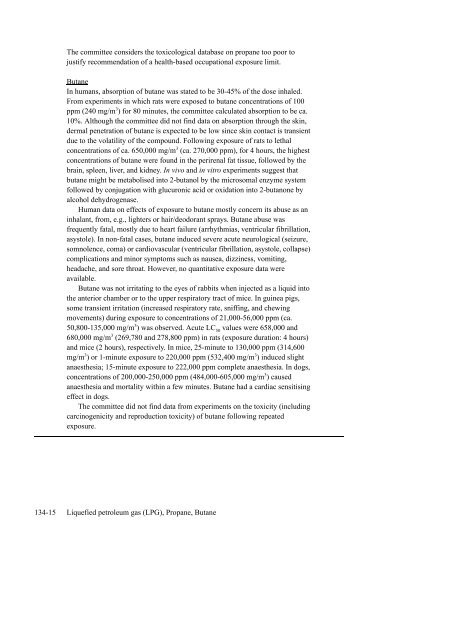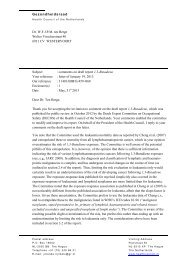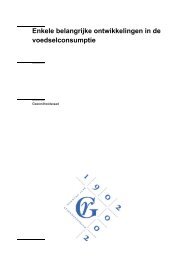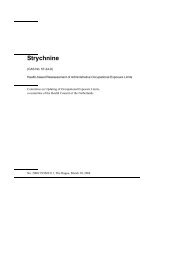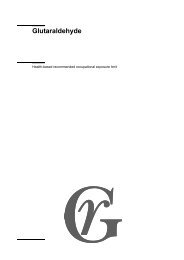Liquefied petroleum gas (LPG) - Gezondheidsraad
Liquefied petroleum gas (LPG) - Gezondheidsraad
Liquefied petroleum gas (LPG) - Gezondheidsraad
You also want an ePaper? Increase the reach of your titles
YUMPU automatically turns print PDFs into web optimized ePapers that Google loves.
The committee considers the toxicological database on propane too poor to<br />
justify recommendation of a health-based occupational exposure limit.<br />
Butane<br />
In humans, absorption of butane was stated to be 30-45% of the dose inhaled.<br />
From experiments in which rats were exposed to butane concentrations of 100<br />
ppm (240 mg/m 3 ) for 80 minutes, the committee calculated absorption to be ca.<br />
10%. Although the committee did not find data on absorption through the skin,<br />
dermal penetration of butane is expected to be low since skin contact is transient<br />
due to the volatility of the compound. Following exposure of rats to lethal<br />
concentrations of ca. 650,000 mg/m 3 (ca. 270,000 ppm), for 4 hours, the highest<br />
concentrations of butane were found in the perirenal fat tissue, followed by the<br />
brain, spleen, liver, and kidney. In vivo and in vitro experiments suggest that<br />
butane might be metabolised into 2-butanol by the microsomal enzyme system<br />
followed by conjugation with glucuronic acid or oxidation into 2-butanone by<br />
alcohol dehydrogenase.<br />
Human data on effects of exposure to butane mostly concern its abuse as an<br />
inhalant, from, e.g., lighters or hair/deodorant sprays. Butane abuse was<br />
frequently fatal, mostly due to heart failure (arrhythmias, ventricular fibrillation,<br />
asystole). In non-fatal cases, butane induced severe acute neurological (seizure,<br />
somnolence, coma) or cardiovascular (ventricular fibrillation, asystole, collapse)<br />
complications and minor symptoms such as nausea, dizziness, vomiting,<br />
headache, and sore throat. However, no quantitative exposure data were<br />
available.<br />
Butane was not irritating to the eyes of rabbits when injected as a liquid into<br />
the anterior chamber or to the upper respiratory tract of mice. In guinea pigs,<br />
some transient irritation (increased respiratory rate, sniffing, and chewing<br />
movements) during exposure to concentrations of 21,000-56,000 ppm (ca.<br />
50,800-135,000 mg/m 3 ) was observed. Acute LC 50<br />
values were 658,000 and<br />
680,000 mg/m 3 (269,780 and 278,800 ppm) in rats (exposure duration: 4 hours)<br />
and mice (2 hours), respectively. In mice, 25-minute to 130,000 ppm (314,600<br />
mg/m 3 ) or 1-minute exposure to 220,000 ppm (532,400 mg/m 3 ) induced slight<br />
anaesthesia; 15-minute exposure to 222,000 ppm complete anaesthesia. In dogs,<br />
concentrations of 200,000-250,000 ppm (484,000-605,000 mg/m 3 ) caused<br />
anaesthesia and mortality within a few minutes. Butane had a cardiac sensitising<br />
effect in dogs.<br />
The committee did not find data from experiments on the toxicity (including<br />
carcinogenicity and reproduction toxicity) of butane following repeated<br />
exposure.<br />
134-15 <strong>Liquefied</strong> <strong>petroleum</strong> <strong>gas</strong> (<strong>LPG</strong>), Propane, Butane


